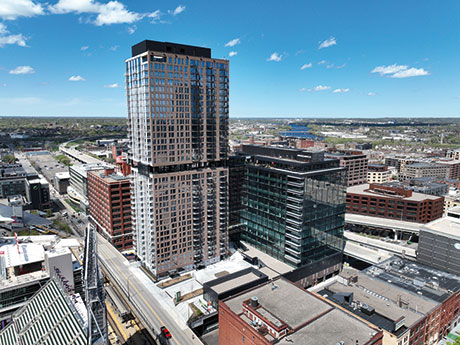By Michael Gelfman, Colliers
Like many major cities across the U.S., the Minneapolis-St. Paul office market remains soft while office users continue to adjust to the shifting dynamics of work brought on by the global pandemic. The gap between performing and non-performing buildings, driven by challenging debt markets, evaporation of building owners’ equity and the impact of hybrid work on office space demand, is growing.
Building owners are faced with difficult and often expensive decisions: spend what’s needed to create a highly amenitized environment (necessary to compete) that attracts tenants and draws employees back to the office or face a race to the bottom. For tenants in the market, this perfect storm has created unprecedented opportunity.

Hybrid work is here to stay
For the last several years, many have wondered where the office market in Minneapolis-St. Paul was heading. The pandemic fundamentally changed the way companies use office space — was hybrid work a temporary solution to a once-in-a-lifetime event or was it here to stay? Today we know the answer: hybrid work is here to stay.
As a result of this seismic shift, some of which is due in part to artificial intelligence, many tenants over the last few years have downsized their footprints to accommodate a workforce that is only in the office two to three days a week. Many Class A buildings benefited from all of the movement in the market as tenants took advantage of favorable market conditions to upgrade their space.
This flight to quality to buildings with robust amenities was seen as an opportunity for tenants to lure workers away from their homes and back to the office.
But the lack of demand drove vacancy in the market of multi-tenant buildings to 18.4 percent as of the second quarter of 2024. In fact, downtown Minneapolis is experiencing a historically high vacancy of 22.6 percent overall.
The difference between success and failure in today’s market all depends on the financial position of a building’s owner. Landlords with cash, who can improve amenity packages and contribute significant tenant allowances, are faring better than cash-strapped owners. We are seeing this play out in real time as some trophy assets in the Minneapolis central business district have been returned to or are being controlled by their lenders with several more in distress with unknown futures.
There are no spec office buildings under construction in the Minneapolis-St. Paul market today and none are expected to break ground until demand rebounds. That may take time as leasing new construction Class A space is nearly double the cost of leasing existing Class A space. In downtown Minneapolis and the I-394 and I-494 corridors, Class A office space costs a tenant between $20 and $25 per square foot net per year. New construction is projected to cost a tenant between $35 and $40 per square foot net.
It is not all bad news, however; there are some bright spots. Micro markets like the West End and North Loop, vibrant live/work/play/stay neighborhoods, with abundant entertainment, dining and cultural amenities, continue to thrive. The West End is demanding the highest rates in the Minneapolis-St. Paul metro area. Class A space in the West End costs between $26 and $36 per square foot net, and the area boasts an impressive 11.5 percent Class A vacancy rate.
The North Loop has been the most desirable neighborhood downtown, leading the way in leasing activity. The North Loop is also home to the newest office construction project in the metro, North Loop Green.
What about Class B?
There is no way around it: the Class B office market is facing an existential crisis. A significant amount of Class B buildings are 40 to 50 years old, and many are, or nearly, functionally obsolete with significant vacancies and expensive re-tenanting costs. Owners of these assets face difficult decisions and must determine whether it’s more cost effective to repurpose these buildings for unintended uses, such as hotels or schools, sell the asset at a steep discount, or demolish them and start over.
Older Class B buildings in prime locations usually fare better as their land holds much of the value. But we estimate that 20 to 30 percent of Class B office inventory is obsolete and could (or should) be demolished in the coming years due to the high costs of renovation and lack of demand for this class of product.
What’s next?
In much the same way landlords have always scrutinized tenants’ financials, many tenants are now scrutinizing landlords’ financials. Tenants want to ensure that landlords have the capacity to fulfill their financial obligations. Lenders and landlords must adapt to the new realties and together figure out how to make their buildings not only functional but also appealing in a world where the traditional office model is no longer relevant.
We no longer need office space five days a week, so it’s time to make real estate relevant in a new way again, while making it economically feasible for owners. This means creating new and exciting workspaces that employees want to return to, spaces that foster collaboration, culture and a sense of community.
Michael Gelfman is an executive vice president with Colliers. This article originally appeared in the September 2024 issue of Heartland Real Estate Business magazine.


